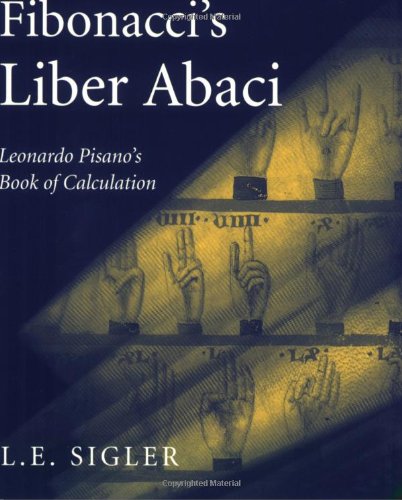Fibonacci's Liber Abaci ebook download
Par gallagher yvonne le lundi, mai 2 2016, 01:06 - Lien permanent
Fibonacci's Liber Abaci. Laurence Sigler

Fibonacci.s.Liber.Abaci.pdf
ISBN: 0387407375,9780387407371 | 637 pages | 16 Mb

Fibonacci's Liber Abaci Laurence Sigler
Publisher: Springer
Amazingly, the number of parts on a plant, the branching arrangements and the spirals of seed heads often follow the Fibonacci sequence. The Wikipedia article gives a lovely illustration of a page from Fibonacci's Liber Abaci which has a table of the Fibonacci numbers F0, … F12. The book advocated numeration with the digits 0–9 and place value. Liber Abaci introduced practical uses for the Arabic numerals 0 through 9 to Western Europe. The Fibonacci sequence is named after Leonardo of Pisa, who was known as Fibonacci. In Liber Abaci, Fibonacci introduced a number sequence that solved a problem relating to the growth of a population of rabbits generation by generation assuming some idealized constraints. It was a solution for a problem that was asked by Leonardo of Pisa (more popularly known as Fibonacci amongst the pretentious one's) in his book Liber Abaci. In it he outlines a puzzle regarding how fast rabbits could reproduce in ideal circumstances. Publisher: Springer Page Count: 637. GO Fibonacci's Liber Abaci Author: Laurence Sigler Type: eBook. In Highschool we studied about Fibonacci Series until it haunted us in our dreams but I never knew that the origin of these numbers is .. In the Liber Abaci (1202), Fibonacci introduces the so-called modus Indorum (method of the Indians), today known as Arabic numerals. In Liber Abaci Fibonacci discussed mathematical problems and calculations. Language: English Released: 2003. His Italian merchant father was a diplomat staioned in Bugia in what's now Algeria in North Africa and Fibonacci was able to travel with him around the Mediterranean world. Fibonacci subsequently travelled broadly, where he learnt from mathematicians of different cultures. Fibonacci is best known to the modern world for: (1) The spreading of the Hindu-Arabic numeral system in Europe, primarily through the publication in the early 13th century of his Book of Calculation, the Liber Abaci. A piece of history worth noting: Leonardo of Pisa (Fibonacci), first wrote about this sequence in his 1202 book, Liber Abaci. In Europe, Fibonacci's Liber Abaci in 1202 described these numbers; the book was meant to introduce the Indian number system and its mathematics which he had learnt in North Africa from Arab teachers. Fibonnaci Analysis - statue of Leonardo Fibonacci An Italian mathematician from the 13th century named Leonardo Fibonacci of Pisa described a special series of numbers in his book 'Liber Abaci'. Fibonacci himself used convention 3 above.